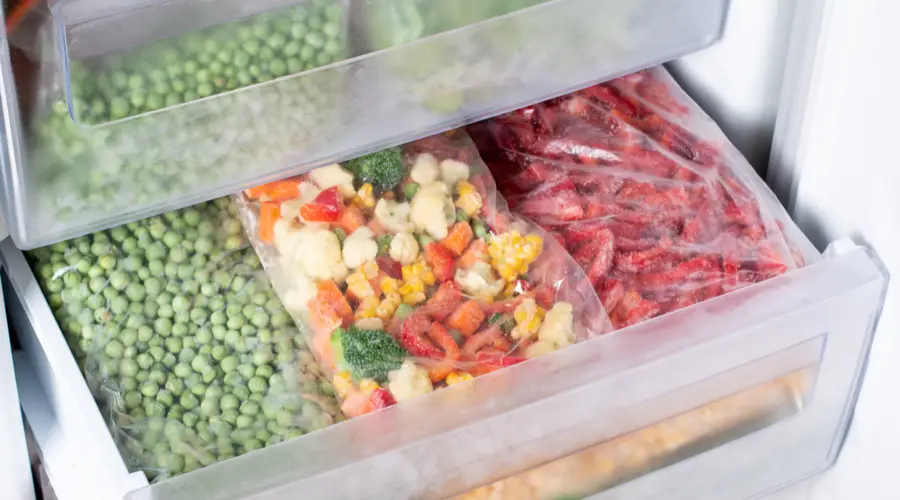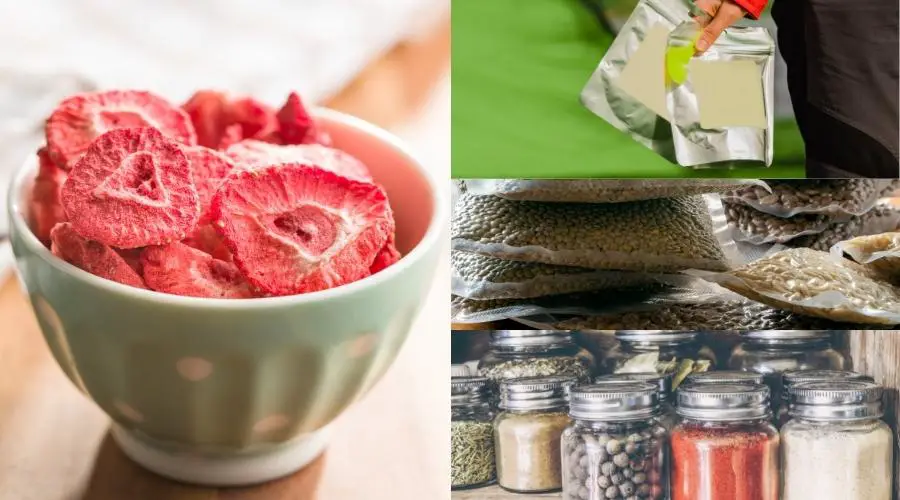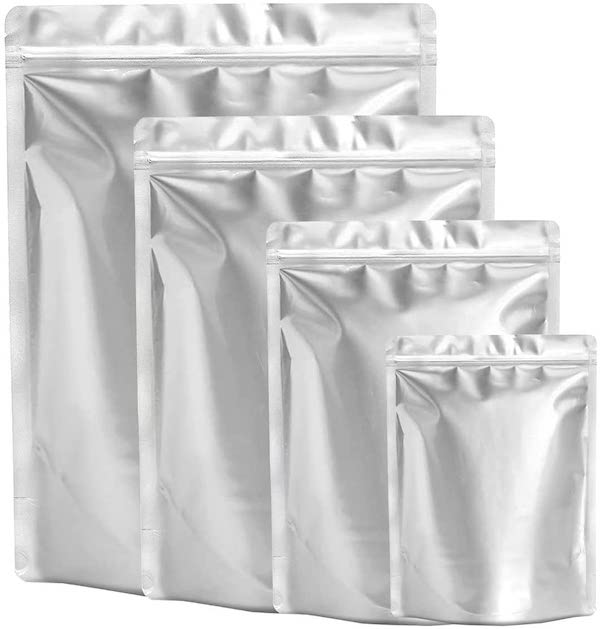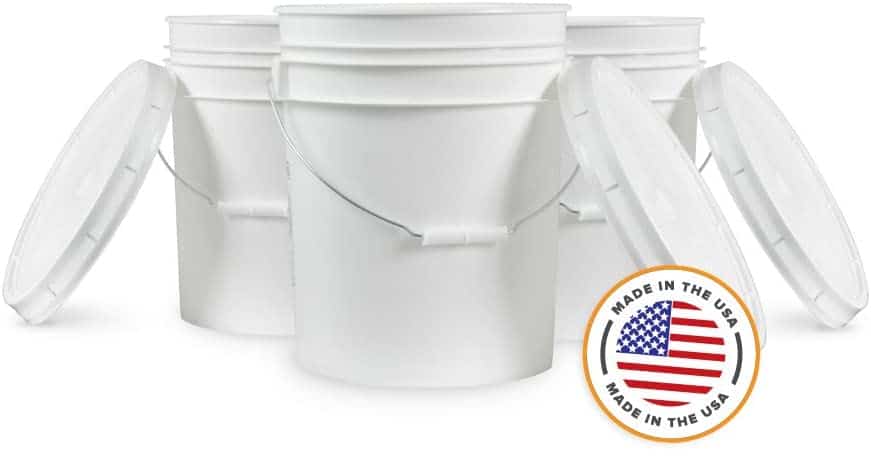When we first started buying freeze dried food and freeze drying our own garden produce, meals, and other foods we consistently asked ourselves two questions. What is the shelf life of different freeze dried foods? And how should we store freeze dried food to get the longest shelf life possible? After hours of research and trying various different packaging and storage conditions we have found several effective ways to store freeze dried food which will help extend its shelf life for years.
How do you Store Freeze Dried Foods?
Freeze dried foods are best stored in sealed airtight containers, such as mylar bags, and kept in an oxygen-free, cool, and dark place that is up off the floor. For example, storing your freeze dried food in mylar bags with an oxygen absorber and then placing those bags in a hard plastic container on a shelf in a cold storage room or pantry will result in the longest shelf life.
The Best Storage Conditions for Freeze Dried Food
- Oxygen-free environment – Place an oxygen absorber in the container with the freeze dried food.
- Cool location – Store freeze dried food in temperatures that stay at or below 70 degrees Fahrenheit.
- Dark location – Store freeze dried food in a location that doesn’t have direct sunlight especially if you use clear packagings such as glass jars or clear plastic bags.
- Off the floor – Keep your food storage off the ground to avoid moisture, animals, and rodents.
Because oxygen and moisture are the biggest culprits to freeze dried food going bad you’ll want to make sure you use the right type of container to store your freeze dried food.
As you add freeze dried food to your food storage it is important to try different foods to see what you like. To get some great ideas see our article Best Freeze Dried Foods: Must-Haves For Any Circumstance. When you’re ready to start freeze drying your own food see our article Buying a Home Freeze Dryer: What You Need to Know First.
Freeze drying food has quickly become one of our favorite food preservation methods followed closely by dehydrating, and canning. Also, see Freeze Dried Vs. Dehydrated Foods: Complete Comparision.
Additionally, it is important to know what factors affect the shelf life of all types of food storage.
6 Types of Containers to Store Freeze Dried Food In
- Mylar bags
- Glass Jars (Mason Jars)
- Vacuum Seal Bags
- Cans
- Plastic Buckets
- Plastic ziplock Bags (short term)
Important to keep in mind…
- storage containers such as glass jars, vacuum seal bags, and even buckets let light in so it is important that they are stored in a dark space such as a storage room or closet as light can decrease the shelf life.
- Mylar bags, vacuum seal bags, and plastic bags are susceptible to rodents. For extra protection, they can be stored in totes or buckets.
1. Mylar Bags
Mylar bags are the most commonly used container to store freeze dried foods. Mylar bags are usually silver in color. They are thick bags that keep food fresh for a very long time. You can write the date and food type right on the bags.
Mylar bags don’t let any light in and are easy to label and store. Unlike glass jars, they won’t break if dropped.
We buy our mylar bags from Harvest Right but you can find great options like these mylar bags on Amazon.
2. Glass Jars (Mason Jars)
Glass jars, also known as Mason jars, are commonly used as containers for storing freeze dried foods. The best part about Mason jars is that they are easy to see what is inside and can be sealed easily.
Glass jars are also great if you plan on using your freeze dried food such as apples or berries for snacks and want them sealed but easily accessible.
Glass jars are clear and let light in so they will need to be stored in a dark place.
Glass jars can be hard to come by depending on the season. These are one of our favorite glass mason jars with an airtight seal on Amazon.
3. Vacuum Seal Bags
Vacuum-sealed bags are another way to store freeze dried foods. Vacuum seal bags are clear plastic so they won’t keep the oxygen and sun out as long as a mylar bag, therefore, decreasing the shelf life but are still a great option if you plan on using the food sooner than a few years.
Remember to store it in a dark, cool place that is off the ground and not accessible to mice or other rodents.
We like to have a couple of sizes of vacuum bags on hand for different things. Our favorite most commonly used vacuum seal bags are these:
See Avid Armor Vacuum Sealer Bags (200 Quart Bags, 6×10 Inch) on Amazon
See Nutri-Lock Vacuum Sealer Bags (200 Quart Bags 8×12 Inch) on Amazon
4. Cans
Tin or aluminum cans such as #10 cans are a common container used for food storage due to their airtight seal, not letting any light in and they stack easily for storage.
Freeze dried food when bought from a company is most often in sealed #10 cans. Because most companies sell their food in bulk this is a really great option for them with size and ease of shipping.
You can store your own freeze dried food in cans but you will need a machine to seal the cans. These can sealers are expensive but are needed to seal cans affectively. Here is a good option All American Flywheel Can Sealer (see the price on Amazon) While these cans stack easily they are not the most cost-effective to do it yourself at home unless it is something you really want to do.
5. Plastic Buckets
Plastic buckets such as 5-gallon buckets are another option for storing freeze-dried foods. We suggest using plastic buckets in addition to Mylar bags or vacuum-sealed plastic bags.
By storing freeze-dried food in individual Mylar or plastic bags and then storing those bags in hard plastic buckets or totes then the freeze dried food will be less likely to have mice or rodents chew a hole through your storage containers and contaminate your food.
Buckets are also stackable making better use of the space you have.
Using both plastic buckets or totes with Mylar bags will allow your freeze-dried food to maintain the longest shelf life possible (15-30 years).
6. Plastic Ziplock Bags
Plastic ziplock bags are perfect for very short-term storage. If you plan on storing the bulk of your freeze dried food but want to keep a small amount out for a snack, plastic bags are a great option that many of us have on hand already.
What is the Shelf Life of Freeze Dried Food and How long does it stay good?
Freeze dried foods have a shelf life of 15 to 30 years and some freeze dried foods can stay good for longer than 30 years when stored properly. Because the process of freeze drying removes up to 97% of the moisture it significantly increases the shelf life.
Freed dried food should be used in 6 months to 1 year after opening. Once you have opened freeze dried food you should still store it in an airtight container to keep oxygen and moisture from the air out which will cause the food to soften and spoil.
How to get the best shelf life out of freeze-dried food:
- Store food in a sealed container or package
- Put an oxygen absorber in the package
- Store in a cool place
- Store in a dry place
- Store in a dark place
- Keep freeze dried food storage off the floor
The Self Life of Over 40 Different Freeze Dried Foods
| Freeze Dried Food | Shelf Life | Shelf life after opening |
|---|---|---|
| Fruits | ||
| Apples | 25 years | 12-18 months |
| Bananas | 25 years | 12-18 months |
| Peaches | 25 years | 12-18 months |
| Strawberries | 25 years | 12-18 months |
| Raspberries | 25 years | 12-18 months |
| Blueberries | 25 years | 12-18 months |
| Black Berries | 25 years | 12-18 months |
| Grapes | 25-30 years | 6-12 months |
| Pineapples | 30 years | 6-12 months |
| Mangos | 30 years | 6-12 months |
| Apricots | 30 years | 6-12 months |
| Vegetables | ||
| Asparagus | 25-30 years | 6-12 months |
| Cucumbers | 25 years | 6-12 months |
| Broccoli | 25 years | 6-12 months |
| Celery | 25 years | 6-12 months |
| Carrots | 30 years | 12-18 months |
| Corn | 30 years | 12-18 months |
| Green Beans | 30 years | 12-18 months |
| Mushrooms | 20 years | 6-12 months |
| Onions | 30 years | 12-18 months |
| Peas | 30 years | 12-18 months |
| Bell Peppers | 25 years | 6-12 months |
| Potatoes | 25 years | 6-12 months |
| Tomatoes | 25 years | 6-12 months |
| Squash | 25 years | 6-12 months |
| Zucchini | 25 years | 6-12 months |
| Protein | ||
| Chicken | 30 years | 6-12 months |
| Ground Beef | 30 years | 6-12 months |
| Turkey | 25 years | 6-12 months |
| Sausage | 25 years | 6-12 months |
| Pork | 25 years | 6-12 months |
| Fish | 10-15 years | 6-12 months |
| Eggs | 10 years | 6-12 months |
| Beans | 30 years | |
| Dairy | ||
| Cheese | 30 years | 6-12 months |
| Milk | 20 years | 6-12 months |
| Sour Cream | 10 years | 6-12 months |
| Yogurt | 25 years | 6-12 months |
| Butter | 10 years | 6-12 months |
| Others | ||
| Honey | 30 years | 6-12 months |
| Orange Juice | 20 years | 6-12 months |
| Ice Cream | 25 years | 6-12 months |
| Herbs | 30 years | 12 months |
Can You Store Freeze Dried Food in the Freezer?
Freeze dried food can be stored in the freezer if stored correctly, however, it is unnecessary to store freeze dried food in the freezer. Freeze dried food when stored and sealed in an airtight container with an oxygen absorber can last 15-30 years on the shelf in your storage room. There is no need to store the food in your freezer to extend the shelf life.
Storing freeze dried foods in a freezer causes the potential to have the seal break on mylar bags introducing moisture to the food therefore significantly reducing the shelf life of the food.
With the potential risk and being totally unnecessary, it is probably best to save the space in your freezer for other items.

How to Store Freeze Dried Food After Opening?
The best way to store freeze dried food after it has been opened is to place it in an airtight container such as a sealable plastic or mylar bag, glass jar, or can along with an oxygen absorber. Also, store it properly by keeping the containers of freeze dried food in a dry, dark, and cool location such as a pantry or cold storage.
Once opened, freeze dried foods will start to reabsorb moisture from the air which will cause them to spoil. The most common storage containers for opened freeze dried food are glass jars or a container with an airtight lid or bags.
I currently have freeze dried onions in a gallon size bag in my pantry that I use regularly in my cooking. I take extra care each time I seal it up to get as much air out as possible.
Remember the more you open the container the more moisture the food is exposed to softening the food and giving an opportunity for it to be exposed to bacteria causing it to spoil.
How Long Does Freeze Dried Food Last After Opening?
Freeze dried food can last up to a year after it has been opened. Once opened the freeze dried food starts to absorb the moisture in the air. Because of this, freeze dried food should be used within 6-12 months.
Once opened the freeze dried food should still be stored in an airtight container to avoid the food being exposed to moisture and going soft or starting to spoil. This will also help get the most shelf life out of your open freeze dried food.
If you plan on using the food quickly and regularly, the best storage for open freeze dried foods are glass jars, plastic bags, or airtight containers. If you don’t plan on using the food quickly or regularly (within a few days) it is best to reseal your food to store it again if it is in a mylar bag or glass jar. So long as no contaminants or moister have gotten into the food you can reseal the food in a mylar bag.

Can You Repackage Freeze Dried Food?
You can and should repackage freeze dried foods especially if the original packaging can’t be sealed and is no longer viable in keeping your freeze dried food free of moisture.
The amount of freeze dried foods in #10 cans can seem like a lot. Things such as onions won’t all be used as quickly as something like mashed potatoes or eggs. So repackaging freeze dried food will allow you to keep storing it for a year or longer without having it go bad.
To avoid wasting food because it got moisture in it or it is something you won’t use all of before the open shelf life is up, you can easily separate freeze dried foods from larger bulk containers into something like mylar bags or glass jars that are in a more realistic consumable amount for you or your family.




